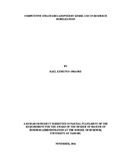Competitive Strategies Adopted by Kemri–cdc in Resource Mobilization Maore
| dc.contributor.author | Omaore, Rael K | |
| dc.date.accessioned | 2016-12-22T12:09:05Z | |
| dc.date.available | 2016-12-22T12:09:05Z | |
| dc.date.issued | 2016-11 | |
| dc.identifier.uri | http://hdl.handle.net/11295/98320 | |
| dc.description.abstract | Despite numerous studies in the area of competitive strategies, there is very little information on research within the non-profit industry. According to the National Health Accounts government support towards healthcare, particularly in terms of funding, has declined significantly over the years. This has consequently impacted health research which falls under the umbrella of healthcare funding. The resultant effect has been that health research organizations and institutions around the country have resolved to assistance from local and foreign funding agencies that provide either financial or non-financial resources on a competitive basis. The research sought to examine competition from a non-profit industry perspective and the strategies adopted to combat competition in resource mobilization. The study sought to identify the competitive strategies in place at KEMRI –CDC that complement the resource mobilization activities. The research adopted a case study design and collected data using interview guides and secondary data. Secondary data was obtained from websites and research publications conducted on similar contexts. Data analysis used a content analysis technique and presented the findings using a qualitative descriptive technique. The findings were assessed based on the direct application of competitive strategies and the extent to which competitive strategy theories were deemed evident. Key findings indicated the application of cost leadership and differentiation as competitive strategies in place to mobilize resources. The resource-based theory along with the knowledge-based theory formed the foundation upon which the study was based; they were significantly evident in the study. The study revealed a close link between the resources of an organization as well as its capabilities and the level at which it is able to compete in the industry it operates. The importance of safeguarding knowledge as a valuable resource in the organization was also revealed supporting further the knowledge based theory. The generic competitive competitive strategies proposed by Porter were also tested in the study to examine the extent to which they influenced resource mobilization. The main competitive strategies evident from the study were the cost leadership and differentiation strategies which were the most common strategies in place. The study further revealed formation of strategic alliances in the form of collaborations with the different partners as a competitive strategy for KEMRI –CDC. The study concluded that competitive strategies are a valuable tool necessary to achieve greater results in resource mobilization. Recommendations were made to the policy makers to increase awareness of strategies existent in the organization in order to increase their effectiveness. Further constant review of existent strategies should also be done to increase their effectiveness. | en_US |
| dc.language.iso | en | en_US |
| dc.publisher | University of Nairobi | en_US |
| dc.rights | Attribution-NonCommercial-NoDerivs 3.0 United States | * |
| dc.rights.uri | http://creativecommons.org/licenses/by-nc-nd/3.0/us/ | * |
| dc.title | Competitive Strategies Adopted by Kemri–cdc in Resource Mobilization Maore | en_US |
| dc.type | Thesis | en_US |



